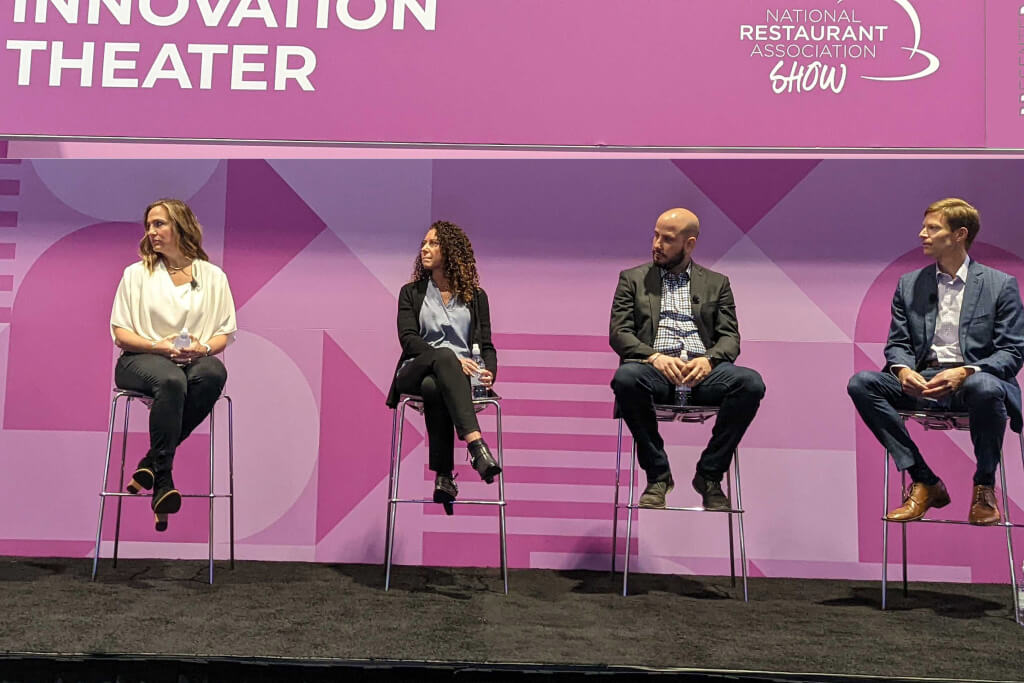
What You Won’t Find in Your SWAG Bag
by Jillian Straw
Did you attend the 2022 National Restaurant Association Show in Chicago?
If you went to the show, you almost certainly got to try free samples of delicious food and drink, plus probably a ton of “stuff we all get” (SWAG) merchandise.
However, if you missed Ottimate’s Tech Talk at The Show, there are a few things you won’t find in your SWAG bag.
Restaurant technology can be a powerful tool in a successful business strategy, but navigating through all of the tech options can feel difficult. However, figuring out the best tech tools from small business (SMB) to mid-market and enterprise levels doesn’t have to be an overwhelming task.
Ottimate’s Tech Talk session brought together a panel of foodservice tech experts and successful operators to discuss new opportunities for automating operations in the hospitality industry. In the session, titled Let Technology Work For You: Insights from SMB to Enterprise, our panelists discussed how they’ve used technology to streamline their systems, improve the bottom line, and strengthen vendor relationships.

Here is an overview of the major themes discussed in the Let Technology Work For You Tech Talk.
Not the Great Resignation—the Great Reallocation
One of the biggest topics discussed across the board at The Show was labor. Hiring new talent and retaining staff are top of mind for many restaurant owners and operators, and some have talked about the idea of the Great Resignation affecting the labor pool.
In a discussion about technology and automation in the back office, our panelists explored the historically low unemployment rate and wages that are increasing across the board. How can tech and automation help address these rising costs and challenges?
At Ottimate, we’ve started to say that, rather than surrender to the Great Resignation, we instead have the opportunity to rise to the occasion of the Great Reallocation. Leveraging automation can transform how your organization approaches labor hours and delegates staff responsibilities. Automation helps allow your staff to do more, through technology.
Panelist Kristina Gansser, VP of Product at Fourth Enterprises, noted that as automation improves, “restaurant owners and managers can focus on their business” instead of repetitive, tedious tasks. “The more we can remove the person from the activity, the more they can focus on their operations,” Kristina added.
Reallocating resources allows restaurants to prioritize what’s most important. Automation still provides restaurants with the information they need, on a timely basis. And by moving repetitive tasks to automation, operators and managers can refocus staff labor hours to the tasks that cannot be automated, like developing staff and interacting with customers.
Retention Can Be Improved through Automation Tools
In such a challenging labor market, retention is top of mind for many operators. If it is difficult to hire new employees, retaining existing employees and reducing attrition becomes even more of a priority.
As our Tech Talk panelists explained, automation tools can play a significant role in your retention strategy. First, automation frees up management from many of the manual processes that used to keep them trapped in the back office. Instead of keying numbers into a computer, your management can focus on interacting with their staff, strengthening connections and refining culture on the team.
In addition, by automating otherwise labor-intensive tasks, your staff can take on different responsibilities. Without time-consuming data entry, the people on your team are free to tackle more value-added roles and advance in their careers. For example, panelist Sean Skuro, VP of Accounting & Finance at One Table Restaurant Group (Tendergreens, Tocaya), explained that after automating the AP process, his former AP clerk moved from just inputting data to running all payroll.
Panelist Leslie Crook, Owner at LC Consulting, emphasized that before the pandemic, much of the impetus behind automation was driven by operators looking for general and administrative (G&A) savings. However, with recent labor issues, the focus for automation has turned to reallocating resources. “You’re putting [employees] on more value-added tasks, bringing them up,” said Leslie. Rather than letting anyone go, organizations are trying to promote employees to new roles. Providing avenues for growth within the team you already have means your organization doesn’t need to constantly seek out new talent.
Automation Can Minimize Errors Across Operations
There is a confidence in knowing that tasks are automated, said our panelists. When you lean toward automation and eliminate multiple points of human interaction, you are also reducing potential human error.
Sean Skuro spoke of how automating data entry made his organization’s Profit and Loss (P&L) statements far more accurate, all while giving time back to team members. Better, more confident decisions could be made with these reports (explored in the next section).
Finally, automation can drive accountability in data accuracy. Manual data entry can result in issues, but automation creates controls that can impact your basis points. Fewer errors can improve your end-to-end business results, from receiving inventory all the way to vendor payments and sales records.
Faster Reporting Enables Proactive Decisions That Benefit Your Bottom Line
The restaurant industry moves very quickly. There is a lot of useful data generated by day-to-day operations, but if you are waiting for reports, everything you do will be reactive. You need timely data to make proactive decisions.
Panelist Liz Schwartz, Owner at EHS Business Solutions, expanded on how automating operations, particularly for data-heavy departments like inventory or AP, creates more time for strategic business decisions. “It allows us to spend more time analyzing, reviewing, talking about the data, instead of entering the data,” said Liz.
Whether it’s overtime hours or an inflated inventory, what starts as a small issue or trend in your data can add up over time. Rich analytics and reporting allow you to proactively make a change in your business, within a relevant time period, before it’s too late and the opportunity has passed.
Automation Can Drive Scalable Operations
For restaurant groups or hospitality businesses in growth mode, automation can be a key component of your scalability strategy. Sean Skuro at One Table Restaurant Group described roughly tripling the organization’s number of locations and adding a second brand, all while still keeping the back office team about the same size. “It’s a very efficient operation through technology,” said Sean.
The “old school” way of keying in sales and vendor invoices, with a dedicated person for different channels, relies on fixed labor hours and is difficult to scale. In contrast, automated systems remove labor as a major limiting factor, and can instead fuel new growth.
Integration Between Technology Systems Is a Priority
Restaurants and other hospitality businesses are using more systems than ever to streamline and automate operations. While these systems can individually simplify tasks, if they don’t talk to one another, your team may be responsible for manually importing and exporting data.
Every system, from POS to payroll to inventory and invoice processing, should be able to “speak” to one another through a full integration. When evaluating solutions, prioritize those that provide full connections between the technology platforms you already use. If possible, all-in-one solutions that offer multiple features can also help you more efficiently process data.
Our panelists stressed the importance of ensuring that your automation and technology systems work together smoothly, rather than requiring manual workarounds and data entry to sync.
Automation Creates More Time for Customer Service
While most of the benefits of automation are typically on the operations side, new technology tools can also impact customer experience.
As our panelists discussed, automation can help free up your existing staff to do more important things, like interact with customers. When your staff is out on the floor instead of inputting data in the back office, you can focus more on guest satisfaction. Especially as you potentially consider adjustments like price changes or simplified menus, extra time spent with guests can help your team stay on top of immediate feedback.
Ready to Get Started with New Automations?
Our panelists ended the Tech Talk with encouraging words for restaurant owners and operators at every stage of the automation journey. Ultimately, no matter the size of your operation, technology tools can be tailored to meet your business needs, objectives, and growth goals.
Interested in learning more about how you can make technology work for your business? To see how you could implement automated invoice processing, data indexing, electronic payments, and more, scroll down and request to see a demo of Ottimate.
Stay up to date on the latest news in AP automation and finance
Related

